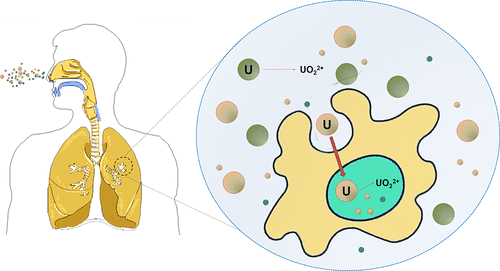当前位置:
X-MOL 学术
›
Environ. Sci. Technol. Lett.
›
论文详情
Our official English website, www.x-mol.net, welcomes your feedback! (Note: you will need to create a separate account there.)
Mineralogy Controlled Dissolution of Uranium from Airborne Dust in Simulated Lung Fluids (SLFs) and Possible Health Implications.
Environmental Science & Technology Letters ( IF 10.9 ) Pub Date : 2018-12-05 , DOI: 10.1021/acs.estlett.8b00557 Eshani Hettiarachchi 1 , Shaylene Paul 2 , Daniel Cadol 3 , Bonnie Frey 4 , Gayan Rubasinghege 1
Environmental Science & Technology Letters ( IF 10.9 ) Pub Date : 2018-12-05 , DOI: 10.1021/acs.estlett.8b00557 Eshani Hettiarachchi 1 , Shaylene Paul 2 , Daniel Cadol 3 , Bonnie Frey 4 , Gayan Rubasinghege 1
Affiliation

|
The recent increase in cardiovascular and metabolic disease in the Navajo population residing close to the Grants Mining District (GMD) in New Mexico is suggested to be due to exposure to environmental contaminants, in particular uranium in respirable dusts. However, the chemistry of uranium-containing-dust dissolution in lung fluids and the role of mineralogy are poorly understood, as is their impact on toxic effects. The current study is focused on the dissolution of xcontaining-dust, collected from several sites near Jackpile and St. Anthony mines in the GMD, in two simulated lung fluids (SLFs): Gamble's solution (GS) and Artificial Lysosomal Fluid (ALF). We observe that the respirable dust includes uranium minerals that yield the uranyl cation, UO2 2+, as the primary dissolved species in these fluids. Dust rich in uraninite and carnotite is more soluble in GS, which mimics interstitial conditions of the lungs. In contrast, dust with low uraninite and high kaolinite is more soluble in ALF, which simulates the alveolar macrophage environment during phagocytosis. Moreover, geochemical modeling, performed using PHREEQC, is in good agreement with our experimental results. Thus, the current study highlights the importance of site-specific toxicological assessments across mining districts with the focus on their mineralogical differences.
中文翻译:

矿物学控制的空气中尘埃中铀在模拟肺液(SLFs)中的溶出度控制及对健康的潜在影响。
据认为,新墨西哥州格兰茨矿区(GMD)附近的纳瓦霍人最近发生的心血管和代谢疾病增加是由于暴露于环境污染物,特别是可吸入粉尘中的铀。然而,人们对含铀粉尘在肺液中的溶解化学和矿物学的作用及其对毒性的影响了解甚少。当前的研究集中于在两种模拟的肺液(SLF)中溶解从GMD的Jackpile和St. Anthony矿山附近的几个地点收集的含粉尘:Gamble's溶液(GS)和人工溶酶体液(ALF)。我们观察到,可吸入粉尘包括铀矿物质,这些铀矿物质会生成铀酰阳离子UO2 2+,作为这些流体中的主要溶解物质。富含尿素和卡诺石的粉尘更易溶解于GS中,后者模仿了肺部的间质状态。相比之下,低尿素石和高岭石的粉尘更易溶于ALF,从而在吞噬过程中模拟了肺泡巨噬细胞的环境。此外,使用PHREEQC进行的地球化学模拟与我们的实验结果非常吻合。因此,当前的研究突出了跨采矿区进行现场特定毒理学评估的重要性,并着重于它们的矿物学差异。与我们的实验结果非常吻合。因此,当前的研究突出了跨采矿区进行现场特定毒理学评估的重要性,并着重于它们的矿物学差异。与我们的实验结果非常吻合。因此,当前的研究突出了跨采矿区进行现场特定毒理学评估的重要性,并着重于它们的矿物学差异。
更新日期:2019-02-07
中文翻译:

矿物学控制的空气中尘埃中铀在模拟肺液(SLFs)中的溶出度控制及对健康的潜在影响。
据认为,新墨西哥州格兰茨矿区(GMD)附近的纳瓦霍人最近发生的心血管和代谢疾病增加是由于暴露于环境污染物,特别是可吸入粉尘中的铀。然而,人们对含铀粉尘在肺液中的溶解化学和矿物学的作用及其对毒性的影响了解甚少。当前的研究集中于在两种模拟的肺液(SLF)中溶解从GMD的Jackpile和St. Anthony矿山附近的几个地点收集的含粉尘:Gamble's溶液(GS)和人工溶酶体液(ALF)。我们观察到,可吸入粉尘包括铀矿物质,这些铀矿物质会生成铀酰阳离子UO2 2+,作为这些流体中的主要溶解物质。富含尿素和卡诺石的粉尘更易溶解于GS中,后者模仿了肺部的间质状态。相比之下,低尿素石和高岭石的粉尘更易溶于ALF,从而在吞噬过程中模拟了肺泡巨噬细胞的环境。此外,使用PHREEQC进行的地球化学模拟与我们的实验结果非常吻合。因此,当前的研究突出了跨采矿区进行现场特定毒理学评估的重要性,并着重于它们的矿物学差异。与我们的实验结果非常吻合。因此,当前的研究突出了跨采矿区进行现场特定毒理学评估的重要性,并着重于它们的矿物学差异。与我们的实验结果非常吻合。因此,当前的研究突出了跨采矿区进行现场特定毒理学评估的重要性,并着重于它们的矿物学差异。



























 京公网安备 11010802027423号
京公网安备 11010802027423号